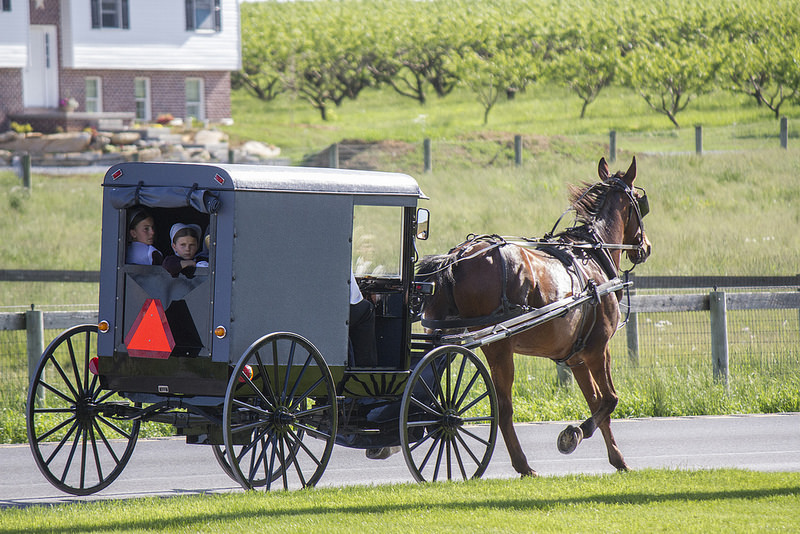The Unfolding Craft Beer Boom In Amish Country

I got hammered in Amish Country. Granted, the headline for this and my experience doing it would have been so much more exciting if I could say that I got hammered with the Amish, maybe having become involved in someone’s knock-down, drag-out rumspringa, which is something I know about Amish culture because of TV. But all I did was drink lots of great beer with other non-Amish folk, and you should too if you ever get the chance.
Lancaster County, aka Pennsylvania Dutch Country, aka Amish Country, is a 1,000-square-mile area in Southeastern Pennsylvania with a population of about a half million, half of which are Amish. It’s 80 miles from Philadelphia, 165 miles from New York, and 120 miles from Washington.
The main reason I point out the proximity of those large cities is that if you were brought to Lancaster blindfolded and asked to guess where you were based on the way the place looks and feels, you would not likely intuit that three of the Top 10 biggest metropolitan areas in the country are within a couple-hour drive. We’re talking rolling farmland, unironic overalls and single-horsepower buggies sharing the road with Fords and Chevys.
Lancaster County has about 20 licensed craft breweries.
The horse-n-buggies, of course, are one of the most visible signs you’re in Amish Country. The first one we encountered, my wife and I decided to guess how many we’d see during our two-day trip. I guessed 25; she guessed 45. Two hours later, we gave up counting because we’d both guessed way, way too low.
All that is to say, tourists from those big cities come to Lancaster and the surrounding area to get away from the noise and pace and to get a peek at the really interesting culture of the Amish, a culture which I won’t get too deep into, mostly because we’re this far in and I haven’t even begun to discuss the beer.
Lancaster County has something like 20 licensed craft breweries, and when you count the breweries just outside of the county the number is probably more like 30. If you’re someone who frequents places with an interesting beer selection, you’ve probably heard a lot of the names: Victory Brewing Co., Troegs, Appalachian Brewing Co., Lancaster Brewing Co. The area is known for its lagers, which is a somewhat underrepresented style in indie brewing, where hoppy IPAs are the most common answer to the skunk-water lagers of the macro breweries. But don’t worry: There are plenty of IPAs being cooked up in Lancaster, as well as styles I hadn’t seen anywhere else.
Wacker Brewing Co. is one of the oldest breweries in the country.
At Wacker Brewing Co. I tasted a gose, which Beer Advocate describes as having a “twang” and which I would describe as tasting more like cheese than beer. (Full disclosure: My palate is not what you would call super refined; I like what I like at any given moment, and sometimes that’s a simple pale ale or pilsner and sometimes that’s a sour beer or IPA and sometimes that’s straight-up Rolling Rock.) Like lager, gose is a German style, and you’re going to recognize that as a trend in breweries around Amish country.
Wacker is one of the oldest breweries in the country and was the first in Lancaster. They credit German immigrants to the area with introducing lager to the U.S. and birthing the brewery revolution that currently has such a strong foothold. Don’t let the cheese beer scare you — they have plenty of other styles that are super drinkable, and they share a space with the Thistle Finch Distillery, so if you somehow don’t find any of their beers to your liking, you can grab a taste of some local gin or white rye.

OK, fine, we should talk about the main reason tourists flock to the area. The Amish culture has been well documented elsewhere, so I won’t go into those details. What I will say is that traveling to a specific place just to kind of observe how someone lives feels very intrusive, though it doesn’t seem to bother the locals much. Everywhere you go there are buggy rides and Amish smorgasbords, the latter of which is essentially just an all-you-can-eat feast of fried chicken, roast beef, buttered noodles, chicken pot pie, sausages, mashed potatoes, some token vegetables and at least four different choices of dessert, including shoo-fly pie, a local specialty with a sort of custardy filling made of molasses that is uber sweet. Apparently, most of the smorgasbords are buffet-style, but the one we went to, charmingly called Plain & Fancy (as seen on Travel Channel, of course), served dinner family-style.
We were seated at a table of about 12, and our server brought us large platters of food to serve ourselves for a very reasonable price. This method, family-style all-you-can-eat, is much better than a standard buffet, for me at least, because despite the fact that the server would bring us more as soon as a platter went empty, I was painfully aware that a bunch of strangers were watching and waiting as I served myself, thus prompting me to eat a more civilized amount than I actually wanted. Don’t get me wrong: I ate way too much, but it was an overeating I didn’t immediately regret, which is not something I can say for many of my buffet experiences, if I’m being honest.
Anyway, as I was saying: Despite the tourist-focused local industry, it feels really weird to drop into someone’s world just to see how they live, like you’re at a zoo where the attractions are people put on display for being different. I get that there’s agency here — it’s not like we were walking up and looking in windows; most of the touristy stuff is well away from the actual Amish community in a controlled environment where the people being gawked at are presenting themselves voluntarily. But not always.
It feels really weird to drop into someone’s world just to see how they live, like you’re at a zoo where the attractions are people put on display for being different.
Each time a horse-n-buggy clopped by on the road, smartphones and DSLRs whirled to capture video and snapshots of what was likely a family headed to the store or a friend’s house or, you know, a funeral or whatever. The point is, Amish people actually live and work and play and exist in this community, so let’s visit and support the local economy and eat too much buttered noodles and shoo-fly pie and pay too much for a buggy ride to people who are voluntarily allowing us to engage them and take video and explore their farms. That’s all great. But I bet we could have some restraint and hold our shutters when someone’s just trying to run an errand in town.
Maybe it’s just me, though, because I’m oversensitive about making people uncomfortable, having been uncomfortable for about three decades myself. But that all made me want to stick mostly to breweries, which is easy to do in Lancaster and would likely have been my preference whatever the rest of the place had to offer. So, back to beer.
Lancaster Brewing Co. has one of the sweetest deals around. For $16 they’ll pour you 4 ounces of every beer they currently have on tap, which when I visited was 13. They also serve what looked and smelled like great food in their brewpub (I would have eaten if I wasn’t worried about saving room for beer). I was able to speak with Lancaster Brewing’s Pete Keares about what makes this area such a hotbed of breweries.
“Pennsylvania has been very progressive on the legal side of things, allowing craft breweries to open and operate,” Pete said.
“Pennsylvania has been very progressive on the legal side of things, allowing craft breweries to open and operate,” Pete said. That and the proximity to densely populated areas, the draw of tourists to the Amish community and the local indie craft spirit are contributing factors, he added. Despite lagers being what the area is known for, his personal favorites are his brewery’s stouts, and I have to agree. The Lancaster Brewing milk stout is one of the best examples of the style I’ve ever had. Their Hop Project #1 is another amazing beer, and I could go on — none of the 13 tasters I shared with one other person went undrank.
There is some direct interaction between the breweries and the Amish community, Pete said. Hop Buggy, one of Lancaster Brewing Co.’s styles I was able to try, is brewed using grain sourced locally from the Amish, though most of the ingredients they brew with come from elsewhere. But I was wondering: Is there a connection between the breweries and the Amish as patrons? Is the rumspringa and secret drinking of the Amish (whose religion forbids it) helping fund the breweries of the area? Maybe it’s no coincidence that all the craft beer in this part of the country shares air with one of the most insular groups of purportedly non-drinkers. Well, it turns out it’s not a coincidence, but for more benign reasons.

“It’s the German culture, the German heritage,” Pete told me. You see, the Amish are descendants of some of those German immigrants that introduced lager to the area and were ultimately responsible for making Lancaster County the beer mecca it is today. Where the dividing line between those two destinies is, exactly, I couldn’t tell you, but the explanation makes perfect sense. On our horse-n-buggy ride (of course we did, and you should too), I was able to ask the Amish driver about the beer situation. Do the Amish ever enjoy a pint? And if not, can you be our DD later? His coy answer was, “Once we get married, we don’t do that anymore.” Got it.
Before we left Lancaster County, we went up to Lititz to see the Wolf Sanctuary of PA and grab lunch at the Bulls Head Pub, where we had the best meal of the trip (sorry, Plain & Fancy), and true to local form, the beer selection was also quite good. The Bulls Head is set up in the style of a traditional English pub, and the comfy interior is plush but not pretentious. Make sure you go hungry, too, because the food is outstanding. Their Scotch eggs are killer and their burgers are perfect. If you head to this area, stop by for a meal and a pint or two or three.
The Wolf Sanctuary has dozens of wolves at any given time.
The Wolf Sanctuary is a nonprofit that takes in wolves from around the country for various reasons, often having to do with people illegally attempting to own one as a pet and finding out that that is not always a great idea. The Sanctuary has dozens of wolves at any given time and is supported in part by scrap meat donations from local restaurants. The tours are extensive and happen only at scheduled times, so plan ahead. An experienced keeper will walk you from pen to pen and tell you about every pack and every animal. They’re knowledgeable and helpful and they definitely have some stories. It’s a worthwhile cause and a cool experience that you should look into if you’re ever there. Make sure you show up on time and leave your video camera in the car, though. You see, unlike for the Amish folks down the road, it’s against the rules to take video of the wolves at the Sanctuary.
Bottom line: If you’re looking for a beer-focused vacation that’s off the beaten path or just happen to find yourself in Southeastern Pennsylvania, you could do worse than checking out the breweries and brewpubs of Lancaster County. Eat awesome food at the Bulls Head or at an Amish smorgasbord, take a buggy ride to a working Amish farm and bring a friend so you can try everything the area has on tap.






















